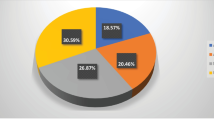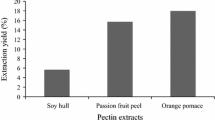Abstract
Pectin is a complex polysaccharide that makes up about one third of the cell wall of higher plants. It was extracted from fruit peels of Irvingia gabonensis and pulp of Cola milleni and Theobroma cacao using acid extraction and alcohol precipitation methods. The effects of temperature and time on the yield and physicochemical properties of the extracted pectin were evaluated. Optimum yields of pectin from C. milleni, I. gabonensis, and T. Cacao were 10.73%, 19.83%, and 11.73% respectively at extracting period of 150 min and temperature of 100 °C. Although there was significant difference in moisture content, degree of esterification, equivalent weight, and methoxyl content of the extracted pectins, there was no significant difference in yield, protein, and ash content at 95% confidence interval. The monosaccharide composition of the three pectins shows that the extracted pectin composed of galacturonic acid and minor neutral sugars. Major functional groups in the extracted pectin show peaks in the region between 1000 and 2000 cm−1. The bands observed between 1627–1651 cm−1 and 1739–1793 cm−1 indicated the presence of the carbonyl group stretching. The surface morphologies of the extracted pectins show irregular shapes, non-smooth surfaces, and unequal sizes which also reveals more silica nodes in cocoa pulp pectin than in other pectins. Thermogravimetric analysis of the pectin samples shows multi-step stages of thermal decomposition, indicating wide range of thermal stability. The overall results specified that the pectins extracted from these plants are suitable for industrial applications.



Similar content being viewed by others
References
McNeil M, Danville AG, Fry SC, Albersheim P (1984) Structure and function of the Primary cell walls of plants. Annu Rev Biochem 53:625–663
Sharma BR, Naresh L, Dhuldhoya NC, Merchant SU, Merchant UC (2006) An overview on pectins. Times Food Processing J. June-July Issue, Page no. 44-51
Kuuva T, Lantto R, Reinikainen T, Buchert J, Autio K (2003) Rheological properties of laccase-induced sugar beet pectin gels. Food Hydrocoll 17:679–684
Sanati RA, Zokaee FF (2007) The effect of pH, ethanol volume and acid washing time on the yield of pectin extraction from peach pomace. Int J Food Sci Technol 42:1177–1187
Kashyap DR, Vohra PK, Chopra S, Tewari R (2001) Applications of pectinases in the commercial sector: a review. Bioresour Technol 77:215–227
Sakai T, Okushima M (1989) Process for preparing pectin U.S. Patent 4835262
Wang S, Chen F, Wu J, Wang Z, Liao X, Hu X (2007) Optimization of pectin extraction assisted by microwave from apple pomace using response surface methodology. J Food Eng 78:693–700
Thakur BR, Singh RK, Handa AK (1997) Chemistry and uses of pectin – a review. Crit Rev Food Sci Nutr 37:47–73
Ratsch C (2005) The encyclopedia of psychoactive plants: ethno pharmacology and its applications. Rochester, Vermont
Atangana AR, Tchoundjeu Z, Foldout JM, Asaah E, Dumb M, Leakey RRB (2001) Domestication of Irvinga gabonesis: phenotypic variation in fruit and kernels in two populations from Cameroon. Agrofor Syst 53:55–64
Ndjouenkeu R, Goycoolea FM, Morris ER, Akingbala JO (1996) Okra (hibiscus esculentus) dika nut (Irvingia gabonensis) polysaccharides. Carbohydr Polym 29:263–269
Ofosua A, Ofori-Kwakye K, Manso SF, Boakye-Gyasi M, Sasu C, Pobee M (2016) Physicochemical and antimicrobial properties of cocoa husk pectin intended as versatile pharmaceutical excipient and nutraceutical. J Pharm:1–12. https://doi.org/10.1155/2016/7608693
Ermias, Teshome (2016) Extraction and characterization of pectin from selected fruit peels waste. Int J Sci Res 6(2):2250–3153
Koubala BB, Kansci G, Mbome LI, Crepeau MJ, Thibault JF, Ralet MC (2008) Effect of extraction conditions on some physicochemical characteristics of pectins from améliorée and mango peels. Food Hydrocoll 22(7):1345–1351
Sood N, Mathur A (2014) Evaluation of pharmacological activities of pectin extracted from apple and citrus pomace. Biolife J 2(4):1203–1217
Carvajal-Millán E, Rascón-Chu A, Márquez-Escalante J, Ponce de León N, Micard V, Gardea A (2007) Maize bran gum: extraction, characterization and functional properties. Carbohydr Polym 6:280–285. https://doi.org/10.1016/j.carbpol.2006.10.006
Vriesmann L, Petkowicz C (2013) Highly acetylated pectin from cacao pod husks (Theobroma cacao L.) forms gel. Food Hydrocoll 33:58–65
Yapo BM, Koffi KL (2013) Extraction and characterization of highly gelling low methoxy pectin from cashew apple pomace. Foods J 3:1–12
Rha HJ, Bae IY, Lee S, Yoo SH, Chang PS, Lee HG (2011) Enhancement of anti-radical activity of pectin from apple pomace by hydroxamation. Food Hydrocoll 25:545–548
Muhamadzadeh J, Mahoonak SAR (2010) Extraction of pectin from sunflower head residues of selected iranian cultivars. World Appl Sci J 8:21–24
Ismail NSM, Ramli N, Hani NM, Meon Z (2012) Extraction and characterization of pectin from dragon fruit (Hylocereus polyrhizus) using various extraction conditions. Sains Malaysiana 41:41–45
Azad AK, Ali MA, Akter S (2014) Isolation and characterization of pectin extracted from lemon pomace during ripening. J Food Nutri Sci 2(2):30–35
Trease GE, Evans WC (1989) Pharmacognosy, 13th edn. ELBS/ Bailliare Tindall, London, pp 345–773
Akpabio E, Jackson C, Ubulom P, Adedokun M, Umoh R, Ugwu C (2011) Formulation and in vitro release properties of va plant gum obtained from Sesamum indicum. Int J Pharm Biomed Res 2(3):166–171
Joye DD, Luzio GA (2000) Process for selective extraction of pectins from plant material by differential pH. Carbohydr Polym 43(4):337–342
Sriamornsak P (2003) Chemistry of pectin and its pharmaceutical uses: a review. Silpakorn Uni Int J 3(1-2):206–228
Prabhudev H, Sneharani AH (2020) Extraction and characterization of pectin methylesterase from muskmelon biowaste for pectin remodeling. J Food Biochem 44:e13237. https://doi.org/10.1111/jfbc.13237
Staniforth JN (1996) Powder flow. In: Aulton ME (ed) Pharmaucetics. The science of dosage form design, 1st edn. Churchill, Livingstone, Longman Group, United Kingdom, pp 600–601
Aulton MA (2007) Aulton’s pharmaceutics: the design and manufacture of medicines. Churchill Livingstone, London
Willats WG, Knox JP, Mikkelsen JD (2006) Pectin: new insights into an old polymer are starting to gel. Food Sci Technol 17:97–104
Garna H, Mabon N, Robert C, Cornet C, Nott K, Legros H, Wathelet B, Paquot M (2007) Effect of extraction conditions on the yield and purity of apple pomace pectin precipitated but not washed by alcohol. J Food Sci 72:C1–C9
Marcon MV, Vriesmann LC, Wosiacki G, Beleski-Carneiro E, Petkowicz CL (2005) Pectins from apple pomace. Polímeros 15:127–129
Sallam E, Ibrahim H, Takieddin M, Shamat MA, Baghal T (1998) Dissolution characteristics of interactive powder mixtures. Part two: effect of surface characteristics of excipients. Drug Dev Ind Pharm 14(9):1277–1302
Acknowledgements
The authors hereby acknowledge Chemistry Department of The Federal University of Technology Akure and Achievers’ University, Owo, Ondo State, Nigeria, for providing an enabling environment for this research work.
Author information
Authors and Affiliations
Contributions
Lajide L. and Adetuyi A. O. provided study concept and design. Material preparation, data collection, and analysis were performed by Oloye M. T. First draft of manuscript was written by Oloye M. T. All authors commented on the previous version of the manuscript; the revised and final version of the manuscript was prepared by Jabar J. M. All authors read and approved the final manuscript.
Corresponding author
Ethics declarations
Conflict of interest
The authors declare no competing interests.
Additional information
Publisher’s note
Springer Nature remains neutral with regard to jurisdictional claims in published maps and institutional affiliations.
Statement of novelty
The study has established possibility of converting waste to wealth through economically friendly precursor (pectin) obtained from postharvest agro-waste materials for local chemical and allied industries.
Rights and permissions
About this article
Cite this article
Oloye, M.T., Jabar, J.M., Adetuyi, A.O. et al. Extraction and characterization of pectin from fruit peels of Irvingia gabonensis and pulp of Cola milleni and Theobroma cacao as precursor for industrial applications. Biomass Conv. Bioref. 13, 2125–2133 (2023). https://doi.org/10.1007/s13399-021-01366-4
Received:
Revised:
Accepted:
Published:
Issue Date:
DOI: https://doi.org/10.1007/s13399-021-01366-4




